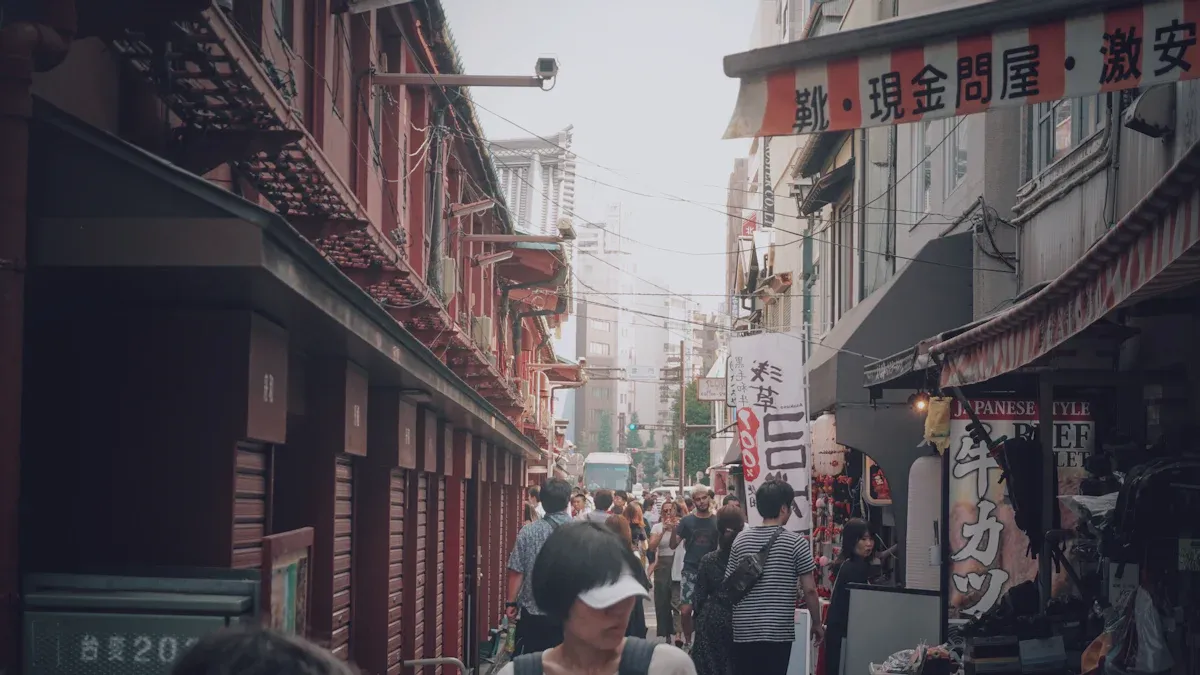What Shoppers Need to Know About Daylight Saving Time Changes

When daylight saving rolls around, you might notice your favorite store changes its trading hours. Maybe you plan to shop after work, but the time shift throws off your routine. Recent surveys show:
Daily card spending jumps after daylight saving time starts.
Spending drops sharply when it ends, especially at grocery and retail stores.
Stay flexible and check those updated hours!
Key Takeaways
Always look at store hours before you shop during daylight saving time changes. This helps you not show up when stores are closed.
Get ready for more spending and shopping when daylight saving starts. The extra sunlight in the evening makes more people go to stores.
Plan your shopping trips before you go. Make a list and check store hours to save time and feel less stressed.
Daylight Saving: Store Hours

Changes in Hours
You might notice that your favorite store opens or closes at different hours when daylight saving starts or ends. These changes can catch you off guard if you do not check ahead. Retailers often update trading hours right when daylight saving begins. For example, some stores change their schedules on specific dates, like March 14th, to match the new time. You may see shifts in trading hours posted on store doors, websites, or social media.
Tip: Always check for updates to trading hours before you head out. Stores may change their hours more than once during the year, especially around daylight saving times.
Here is what you can expect:
Stores may open earlier or stay open later to match the new daylight hours.
Some shops adjust their trading hours only for a few weeks, while others keep the new schedule until the next daylight saving change.
Changes to trading hours can happen quickly, so it helps to stay alert for new announcements.
Why Stores Adjust
You might wonder why stores bother with all these changes. The answer is simple: daylight saving brings more sunlight in the evening, and that encourages people to shop after work or school. Retailers want to make the most of this extra daylight. The Chamber of Commerce has supported daylight saving for years because it helps boost sales. When stores stay open during brighter hours, more customers walk in.
Here are some reasons stores adjust their hours during daylight saving:
More evening sunlight means shoppers feel safer and more willing to visit stores.
Retailers see a jump in sales for things like golf and barbecue supplies during daylight saving. For example, just one extra month of daylight saving can bring in $200 million for golf and $100 million for barbecue businesses.
Stores want to match their trading hours with the times when you are most likely to shop.
You will see these shifts in trading hours at the start and end of daylight saving time. Sometimes, stores or even whole shopping centers update their trading schedules more than once, depending on what works best for their customers. If you keep an eye on these changes, you will not miss out on your shopping plans.
Impact on Shopping Habits

Daylight Saving Time Effects
When daylight saving begins, you might feel like you have more time in your day. The sun stays out longer, and you may want to shop after work or school. Stores often change their hours to match this new pattern. You might notice shifts in trading hours, especially at places that sell outdoor items or have outdoor seating. Garden centers and restaurants with patios often see more customers during these times.
Note: More daylight can make you feel safer and more relaxed when shopping in the evening.
You may also see changes to trading hours posted at your favorite stores. These changes can happen quickly, so it helps to check before you go out. The extra sunlight can encourage you to visit shops later in the day, and stores want to make sure their trading hours fit your new routine.
Spending Patterns
Your shopping habits can change a lot during daylight saving. When the clocks move forward, you might spend more money. Card spending usually goes up by about 3.5% at the start of daylight saving. In Los Angeles, for example, people spent almost 1% more in the 30 days after the time change. Outdoor-focused businesses, like golf courses, see a big boost. The golf industry alone makes hundreds of millions more each year because people have more time to play in the evening.
But when daylight saving ends, you may notice a drop in your spending. Card spending can fall by 3.5% in the month after the clocks go back. You might feel less like shopping when it gets dark earlier. This can lead to fewer impulse buys and less time spent browsing. Retailers feel the impact too. They may see fewer customers and lower sales, which can affect how they plan their trading hours for the next season.
Here’s a quick look at how daylight saving can impact trading times and your shopping:
You may shop more in the evening when there is extra daylight.
Stores adjust their hours to match when you want to shop.
Spending goes up when daylight saving starts and drops when it ends.
Outdoor businesses benefit the most from longer daylight hours.
Less daylight can mean less impulse shopping and lower sales for stores.
Tip: Always check for updates to trading hours, especially around daylight saving times. This helps you avoid missing out on shopping or arriving when stores are closed.
You can see how these changes in time and trading hours shape your habits. The impact trading times have on your routine can be big, so staying aware of shifts in trading hours helps you make the most of your shopping trips.
Adapting to New Trading Hours
Check Store Times
You want to avoid showing up at a store only to find the doors locked. Always check the store’s website or app for the latest trading hours. Many stores update their schedules at the beginning of daylight saving time. You might also see changes to trading hours posted on social media or at the entrance. If you use delivery or pickup services, make sure your carrier knows about the new hours. This helps prevent missed deliveries and keeps your plans on track. Technology can help too. Update your GPS or scheduling apps so you always know the correct time and normal trading hours.
Plan Your Visits
Planning ahead saves you time and stress. Make a quick list before you leave home. If you shop for groceries or pick up online orders, double-check the trading hours for each store. Some stores may have permanent changes, while others switch back after daylight saving ends. Communicate with delivery drivers about any changes to trading hours. This helps everyone stay on schedule. You can also use tracking tools to see if your order will arrive during the new trading hours.
Adjust delivery and pickup times with your carrier.
Talk to drivers about their rest periods and schedules.
Update your tracking apps for accurate delivery times.
Use Extra Daylight
Take advantage of the extra daylight after work or school. Evening shopping feels safer and more relaxed when the sun is still out. Well-lit shopping areas make you feel secure and encourage you to spend more time browsing. Retail analysts say that extra daylight boosts spending in restaurants, entertainment, and outdoor activities. You might notice more people dining out or shopping later. If permanent daylight saving time ever becomes law, you could enjoy these benefits all year. More daylight means more time for fun and shopping after normal trading hours.
Tip: Use the extra hour to explore new stores or enjoy a meal out with friends.
Broader Effects of Daylight Saving
Economic Impact
You might not realize how much daylight saving affects the economy. When stores change their trading hours, you see more people shopping in the evening. This extra sunlight brings more customers to stores, restaurants, and outdoor businesses. Here are some ways the economy feels the impact:
Retailers and businesses that stay open longer see more sales during evening hours.
A seven-week extension of daylight saving once brought 7-Eleven stores an extra $30 million in revenue.
The golf industry can make $200 million to $300 million more when daylight saving lasts longer.
In the European Union, the leisure sector saw a 3% jump in revenue during daylight saving.
Convenience stores report a 1-3% increase in evening foot traffic.
Card spending goes up by almost 1% per person during the spring time change.
People spend about 2.5% more on outdoor recreation goods during these periods.
Retailers also face some challenges. When trading hours shift, employees may work longer or shorter shifts. Sometimes, workers get unexpected overtime pay, especially in the fall when the clocks go back. Payroll teams must watch these changes closely to keep everything fair.
Well-being Tips
Changing trading hours can throw off your routine. You might feel tired or out of sync for a few days. Here are some tips to help you adjust and feel your best:
Go to bed 15 minutes earlier for three nights before the time change.
Get outside for 30 minutes of bright light after you wake up. This helps reset your body clock.
Try taking a small amount of plant melatonin before bed if you have trouble sleeping.
Avoid eating late meals so your body clock does not shift.
Exercise in the early morning or mid-afternoon to help your body adjust.
Drink plenty of water and add trace minerals to stay alert and focused.
If permanent daylight saving time ever becomes law, you might not have to deal with these changes every year. Until then, staying flexible with your trading hours and routines can help you shop smarter and feel better.
Daylight saving time changes can shift your shopping habits and store hours. You might notice coffee shops get busier in the morning or quieter at night.
Set calendar reminders for time changes.
Check store hours before you go.
Tip: Double-check your routines so you never miss out on shopping.
FAQ
What should you do if a store changes its hours for daylight saving time?
Always check the store’s website or app before you go. You can also call the store or look for updates on their social media pages.
Can you shop online during daylight saving time changes?
Yes! Online stores stay open all the time. You can shop whenever you want, even if local stores change their trading hours.
Why do some stores open earlier or close later after the time change?
Stores want to match your new routine.
Extra daylight means you might shop later.
Retailers hope to see more customers in the evening.
See Also
Essential Corner Store Items And Their Importance
Upcoming Changes to Walmart's Self-Checkout System in 2025
Understanding AI-Driven Corner Stores: Key Insights for Retailers
How Cloudpick's Checkout Technology Improves Customer Experience
